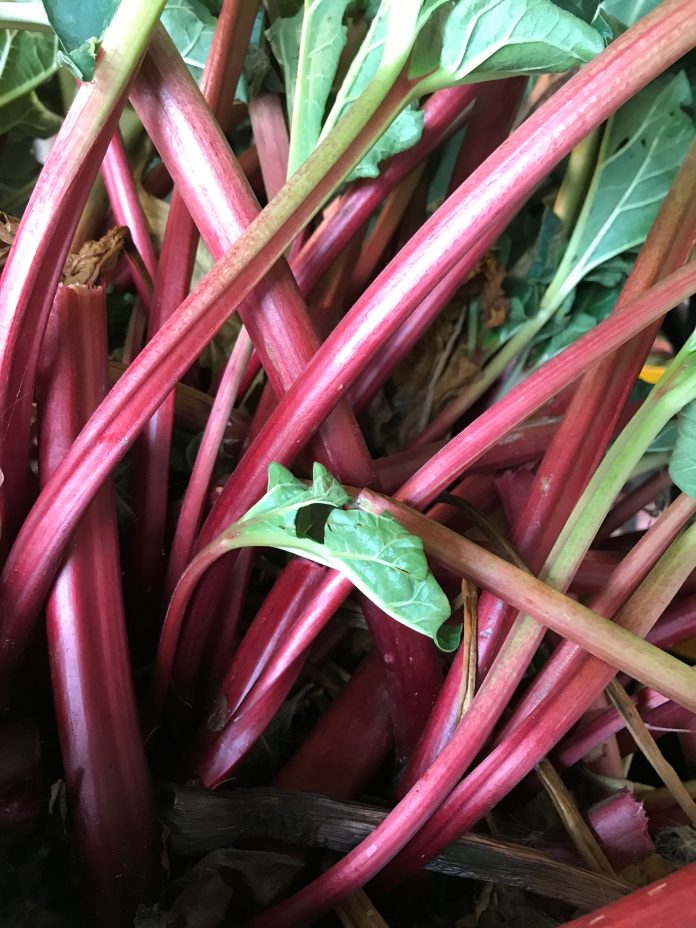When I was young, I was convinced that rhubarb grew wild on the Prairies. Every farm that I visited and every abandoned farmyard that I drove past seemed to have a giant rhubarb plant in it. Rhubarb, however, was introduced to the Prairies by early settlers and originally entered North America via Maine and Massachusetts. Its origins are in parts of China (Chinese Rhubarb) and Russia (Russian rhubarb); growing wild in the cold climate of Mongolia, the Himalayas and Siberia. Records show that rhubarb grew on the banks of the Volga river over 3000 years ago. At that time, it was not used in culinary dishes: only the root was used for medicinal purposes. Records from 2700 BC in China indicate that the Chinese rhubarb root (Rheum palmatum) was used extensively as a laxative but also known for curing fevers, preventing the plague, reducing inflammation and healing soldiers. Chinese rhubarb (also known as Turkey or Indian rhubarb) has a much stronger taste and medicinal properties that the rhubarb commonly found in the North American garden (Rheum rhaponticum). The rhubarb that is grown on the Prairies today is a hybrid that was developed in the nineteenth century: the roots have little or no medicinal value.
Rhubarb is one of the few perennial vegetables that survive our harsh Prairie winters. Since it is a perennial vegetable, it is best to plant it along the edge of the vegetable garden where the roots will not be disturbed by tillage or digging. Rhubarb grows best in full sun and rich soil.
Rhubarb seeds will germinate, however, the resulting seedlings can vary greatly in flavour, texture and leafstalk color. it is most efficient to grow rhubarb from disease-free root divisions: dividing roots of a desirable plant ensures that you clone the characteristics that you want. Although rhubarb doesn’t need much care once it is established, it requires a good start. Rhubarb prefers fertile, well-drained soil Dig a hole that is .45m – .6m square. If you are planting a bigger plant or root division, dig the hole to at least twice the size of the plant. Space rhubarb plants at least 1.5m apart. Mature rhubarb plants can be 1-1.75m wide with 2m high flower stalks. The top of the crown should be no more than 5-7 cm below the soil surface. Fill the hole with a mixture of soil and compost (or well rotted manure). Add ½ cup of 10-10-10 fertilizer mixed in with the compost/soil mixture. Pack the soil firmly around the roots and crown being careful not to damage the crown. Fill the hole with the soil/compost/manure/fertilizer mixture until it is level with the surrounding soil. Water in the newly planted rhubarb however, avoid overwatering rhubarb: this will encourage root rot. Spring is the preferred time to plant rhubarb, but planting can occur any time during the growing season.
Later in the season, rhubarb plants may produce flower stalks. On young rhubarb plants, these flower stalks should be cut off near the base. By cutting off flower stalks, the plant will focus all of its extra resources into the roots and leaves rather than using resources to produce seed. Mature rhubarb plants are not negatively affected by seed production.
Rhubarb has few disease or insect problems on the Prairies. Gardeners should be aware of red-leaf disease, however. As the name suggests, red leaf disease is characterized by red or yellow leaves on a rhubarb plant that is losing vigour. The plant will be reduced in size and the crown of the plant may be rotting with leaves eventually turning black or brown. There is no cure of this disease: infected plants should be removed from the garden immediately. Do not replant a new rhubarb plant in the infected area and do not put the infected plant in the compost.
Rhubarb on the Prairies is typically used in desserts, jams, jellies or sauces. Oxalic acid is what gives the rhubarb its tart flavor. Oxalic acid can be poisonous when ingested at high levels. Large amounts of oxalic acid in our body can result in poor calcium uptake and kidney stones. Rhubarb leaves and roots have high enough levels of oxalic acid to be poisonous. Ensure leaves at the top of the petiole and rootstalk at the base of the petiole are completely trimmed off before cooking. Cooking or steaming rhubarb petioles reduces the level of oxalic acid in the petiole. Petioles can safely be eaten raw in moderate amounts. The flower stalks on rhubarb can also be eaten. The flower stalks usually have the texture of cauliflower along with a strong, sour flavor.
Jackie Bantle is a horticulturist working in the Department of Plant Sciences at the University of Saskatchewan. This column is provided courtesy of the Saskatchewan Perennial Society. Check our website (www.saskperennial.ca) or Facebook page
16 C
Prince Albert
Thursday, April 25, 2024


